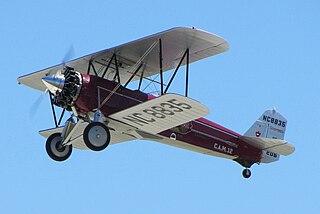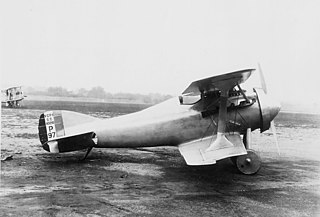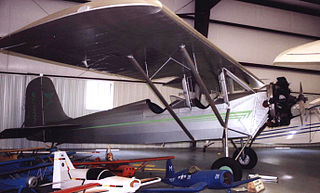Related Research Articles

The Pitcairn Mailwing family was a series of American mail carrier and three-seat sport utility biplane aircraft produced from 1927 to 1931.

The Cunningham-Hall Model PT-6 was an American six-seat cabin biplane aircraft of the late 1920s and was the first design of the Cunningham-Hall Aircraft Corporation of Rochester, New York.

The Northrop Beta was an American single-engine, all-metal, low-wing sporting monoplane built in 1931.

The Kreider-Reisner Challenger was an American utility biplane aircraft designed and produced by the Kreider-Reisner Aircraft Company, which was later taken over by the Fairchild Aircraft Company.

The Keystone K-78 Patrician was an airliner developed in the United States in the late 1920s, built only in prototype form.

The Stearman C3 was an American-built civil biplane aircraft of the 1920s, designed by Stearman Aircraft of Wichita, Kansas. It was also the first Stearman aircraft to receive a type certificate.

The Verville VCP was an American single-engined biplane fighter aircraft of the 1920s. A single example of the VCP-1 was built by the United States Army Air Service's Engineering Division, which was later rebuilt into a successful racing aircraft, while a second, modified fighter was built as the PW-1.

The Viking B-8 Kittyhawk was an American single-engine open-cockpit biplane of the early 1930s.

The Waco A series is a range of light American-built twin side-by-side seater sporting biplanes of the early 1930s.

The Waco 9 is an American-built three-seat biplane design that first flew in 1925.

The Timm Collegiate was a series of American-built two-seat light aircraft of the late 1920s.

The Swallow Airplane Swallow is an American-built general purpose biplane of the mid- to late 1920s.

The Curtiss O-40 Raven was an American observation aircraft of the 1930s which was built and used in small numbers. A single example of the YO-40, a single-engined Sesquiplane with a retractable undercarriage was built, followed by four examples of a modified monoplane version, the O-40B, which remained in use until 1939.
The Waco 6, designed by the Advance Aircraft Company, was a 2-seat biplane similar to the Curtiss JN-4, with single bay equi-span wings. The fuselage was built from wood, fabric covered, with tandem cockpits, the forward one between the mainplanes. Four aircraft were built ca. 1923.

The Waco E series is a small family of American-built cabin biplanes built between 1939 and 1942, which differed primarily by engine installation.
The Travel Air 1000 was an American single-engined biplane, the first product of the newly formed Travel Air Manufacturing Company of Wichita, Kansas. It led to a line of Travel Air biplanes produced until 1930 when the company was bought by Curtiss-Wright.

The Laird LC-B was a three seat, single-engined biplane, built for private owners in the U.S. in the late 1920s and offering a variety of engines. About 35 had been built before production ceased in the mid-1930s. Two have been restored to flight.
The Simplex Red Arrow was a US single-engined monoplane produced in the late 1920s and early 1930s and intended as club machine or mail transport. Most used radial engines in the 90–110 hp (67–82 kW) range. They carried one or two passengers whose seats could be open or enclosed. One variant, the Red Arrow Dual Plane, was easily converted from monoplane to biplane and was available with two versions of the much more powerful Wright Whirlwind engines. In all about 20 were built.

The Butler Blackhawk and the Skyway from which it was developed were American three-seat open-cockpit single engine biplanes of the late 1920s that were built in small numbers immediately prior to having their intended production run interrupted by the onset of the Great Depression.

The Wiley Post Model A is a U.S. two seat sports biplane, built in small numbers in the 1930s.
References
- Notes
- ↑ Detroit News
- Bibliography
- Detroit News, 10 September 1930